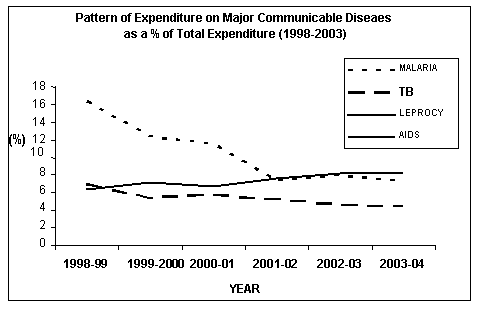 People's Democracy
People's Democracy
(Weekly
Organ of the Communist Party of India (Marxist)
No. 14
April 04, 2004
(Weekly
Organ of the Communist Party of India (Marxist)
|
Vol.
XXVIII
No. 14 April 04, 2004 |
Ill
Health Of The Health Sector Under The NDA Rule
THE
NDA rule has been marked by sharp cutbacks in capital expenditure on social
sectors, the health sector being particularly affected.
Despite the fact that India is among those countries, which hopelessly lag
behind most others with regard to human development, the government claims that
it has made considerable progress in health care. The health ministry has
claimed that prices of essential drugs have come down and have announced its
intention of creating more centres of excellence in the line of AIIMS in several
states. However, hidden behind these claims and declarations of intent, are the
grave realities of Indian health care system, where millions have little or no
access to basic health care facilities.
INDIA’S LOW HDI RANK
While
the NDA government has been suffering from a hallucination of late that India is
poised to become a developed country within the next two decades, its health
indicators compared to other developing countries bring out the true picture. The
Human Development Report 2003 ranked India 127 out of a total of 175
countries. India’s Human Development Index (HDI) rank was 124 in 2002 and 115
in 2001. Thus the celebration of a ‘Shining India’ is taking place at a
time when we have been gradually sliding behind other countries in terms of
basic indicators of development. If we compare India’s performance with some
selected developing countries in terms of some basic social sector indicators,
our backwardness appear starkly.
HD
Indicators Some Selected Developing Countries
|
COUNTRY |
BRAZIL |
MALAYSIA |
SRILANKA |
CHINA |
INDIA |
|
HDI
rank |
65 |
58 |
99 |
104 |
127 |
|
Life
expectancy at
birth |
68.1 |
73.1 |
72.6 |
71 |
63.9 |
|
Maternal
Mortality (per
100,000 live births) |
160 |
41 |
90 |
55 |
540 |
|
Infant
mortality (per
1000 live births) |
31 |
8 |
17 |
31 |
67 |
|
Population
with access
to affordable drugs
|
0-49% |
50-79% |
95-100% |
80-94% |
0-49% |
Source:
Human Development Report 2003
The pathetic state of affairs as far as life expectancy, infant or maternal mortality and people’s accessibility to drugs are concerned, as brought out by the above Table 1 is easily explained by the Figure 1 which shows that India lags behind all the other countries mentioned above in terms of both public health expenditure as a proportion of GDP as well as per capita health expenditure.

Source:
Human
Development Report 2003
The
proportion of public expenditure on health to GDP in India is only
0.9 per cent of GDP
while the average public spending of Less Developed Countries is 2.8 per cent
of GDP. Only 17 per cent of all health expenditure in India is borne by
the government, the rest being borne privately by the people, making it one of
the most highly privatised healthcare system of the world.
Many
people die of communicable
diseases
in India and the resurgence of some like Malaria and Tuberculosis have also been
observed in the recent past. However, the allocations in the Health Budget for
combating major communicable diseases have gone down during the NDA rule (AIDS
being the only exception). Among the major communicable diseases, allocation for
the control of Malaria as a proportion of total expenditure on combating
communicable diseases has gone down from 16.34 per cent in 1998-99 to 7.22 per
cent in 2003-04; in case of TB it has fallen from 7 per cent to 4.37 per cent in
the same period.
Figure 2


Expenditure
Budget: 1998-2003
While
the government is keen on advertising its pious intentions of creating AIIMS
like centres of excellence across the country, expenditure budgets show that
capital expenditure in the health budgets of the Central government actually
declined from Rs 45.09 crore in 1996-97 to only Rs 7.3 crore in 2001-02.
GROWING INEQUALITIES
Infant
mortality rate (IMR) remains at 70 per 1000 births in India. In the poorest 20
per cent of the population the IMR
is 2.5 times higher
than that in the richest 20 per cent of the population. The figures are even
higher at 83
for SCs and 84.22 for STs. The
ratio of hospital beds to population in rural area is 15
times
lower than that of the urban areas and spending on public health is 7 times
lower in rural areas. The ratio of doctors to population in rural areas is 16
times
lower than availability of doctors in urban areas.
The
worsening of the child sex ratio in the country from 945 in 1991 to 927 as
revealed by the Census 2001, points to the growing incidence of female
foeticide
and infanticide in the country. It
is ironical that some of the more prosperous states of India like Punjab,
Haryana, Gujarat and Delhi have registered the sharpest fall in the child sex
ratio between 1991 and 2001.
Sex
Ratio In Some Selected States
|
States |
Sex
Ratio (Females
per 1000 Males) |
Child
Sex Ratio (0-6
age group) |
||
|
|
1991 |
2001 |
1991 |
2001 |
|
India |
927 |
933 |
945 |
927 |
|
Punjab |
882 |
874 |
875 |
793 |
|
Haryana |
865 |
861 |
879 |
820 |
|
Gujarat |
934 |
921 |
928 |
878 |
|
Delhi |
827 |
821 |
915 |
865 |
|
Rajasthan |
910 |
922 |
916 |
909 |
|
Himachal Pradesh |
976 |
970 |
951 |
857 |
Source: Census 2001 and UNFPA
NATIONAL HEALTH POLICY 2002
The
National Health Policy (NHP), which was announced by the NDA government in 2002,
had abandoned the concept of “comprehensive
and universal health care”,
which India was committed to as a signatory to the Alma-Ata Declaration on
Primary Health Care of 1978. While
remaining silent on the need to review the ill-conceived population
control programme, which has proved to be a massive failure causing a huge drain
on primary health care, the NHP 2002 instead argues for the virtual dismantling
of the latter. The NHP also remains silent on drug prices and manufacturing with
the ministry of industries taking over the decisions about Drug Policy. Glossing
over the burning issues concerning basic healthcare, the NHP instead argues for greater
privatisation —
privatisation of existing public hospitals, creating new private hospitals and
subcontracting public health to NGOs, besides emphasising on the creation of
health facilities to attract foreign exchange and promoting health
tourism.
The National Health Policy document actually exposes the insensitivity of the
NDA government towards the dire need to strengthen and expand the public health
system in India and its lop sided priorities in promoting health tourism while
millions of Indians die of preventable communicable diseases.
DRUG PRICES
The
NDA government’s claim of bringing down drug prices is indeed a shameless one.
The fact of the matter is that the pharmaceutical industry has been deregulated
to a great extent, the number of drugs under price control coming down steadily
over the years and stood at 73 in 2003. The Drug Policy announced by the NDA
government in 2002 recommends that the number of drugs under price control be
further reduced to 25.
Number
of Drugs under Price Control
|
1970 |
1979 |
1987 |
1995 |
2003 |
Proposed
in the Drug Policy, 2002 |
|
All drugs |
347 |
163 |
76 |
73 |
25 |
As
a result of the policies of decontrol, prices of drugs have increased several
times, many drugs being sold at 200 to 500 per cent profit margins, with only 20
per cent of the population having an access to all essential drugs they require
(Policy Brief, National
Coordination Committee for Jana Swasthya Sabha, 2004). Prices
of many commonly used antibiotics, anti-diabetics and analgesics have increased
substantially. A study by Wishvas Rane (‘Have Drug Prices Fallen?’,
published in EPW, 1-7 November 2003) show that out of the 253
formulations (sold by the 73 top selling brands in 2000), 169 (67 per cent) show
a price rise, while only 49 (19 per cent) show a price declines. In case of
35 (14 per cent) there has been on a changed in prices.
The
National Health Policy coupled with the Drug Policy announced in 2002 by the NDA
government aims at greater privatisation and market domination in the health
sector.
These policies also aim at dismantling the existent public facilities even when
the experiences worldwide show that development in healthcare can only come
about through enhanced public investment. The NDA rule has not only failed to
improve the health situation in India, it has actually adopted a course which is
leading to a reversal of the gains that were registered in the post independence
era.